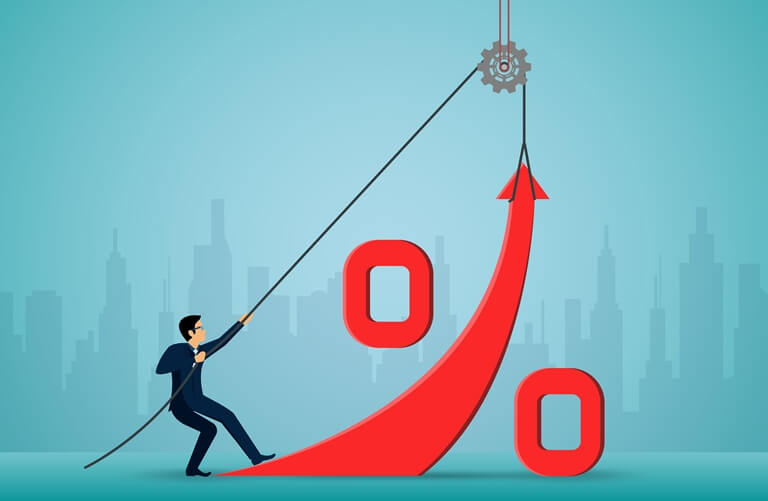Role of Interest Rate in the World Economy
Interest rates are a fundamental tool of monetary policy and play a critical role in the global economy.
The decisions made by central banks and other monetary authorities regarding interest rates can have far-reaching impacts on individual economies, financial markets, and even people’s everyday lives.
From affecting the cost of borrowing and lending to influencing exchange rates and inflation, interest rates are a powerful lever for managing economic growth, stability, and prosperity.
Whether you’re a business owner, investor, or everyday consumer, understanding the impacts of interest rates on the global economy is essential for making informed decisions about your financial future.
So let’s dive into the article below and have a clear understanding of the role of interest rates in the world economy.

What are interest rates?
Interest rates refer to the percentage rate that a borrower pays to a lender for the use of money. It is the cost of borrowing money or the return earned on lending money.
Interest rates are determined by various factors, including the supply and demand for credit, inflation rates, the monetary policies of central banks, and the creditworthiness of the borrower.
When the interest rate is low, it is generally easier and cheaper for people to borrow money, which can stimulate economic growth. Conversely, when interest rates are high, borrowing becomes more expensive, which can slow down economic activity.
It can be applied to various types of loans, including mortgages, car loans, credit cards, and personal loans. They can also apply to savings accounts, where banks pay interest to depositors for keeping their money in the bank
Importance of interest rates in the world economy
Interest rates are a crucial component of the world economy and have a significant impact on the financial markets, businesses, consumers, and government policies. Here are some of the key reasons why interest rates are important:
Monetary Policy
Central banks around the world use interest rates as a tool to implement monetary policy. By increasing or decreasing interest rates, central banks can influence the supply of money, inflation, and economic growth.
Lowering interest rates can encourage borrowing and spending, which can stimulate economic activity while raising interest rates can cool down an overheating economy and combat inflation.
Investment and Capital Flows
Interest rates play a vital role in determining the attractiveness of different investment options. Higher interest rates tend to make fixed-income investments more appealing, while lower interest rates can drive investors towards higher-risk investments, such as stocks or real estate.
Additionally, interest rate differentials can influence capital flows between countries, impacting exchange rates and international trade.
Consumer Spending and Saving
Interest rates can impact consumer behavior by influencing the cost of borrowing and saving.
Low-interest rates can encourage consumers to borrow more, such as taking out mortgages or buying cars, while high-interest rates can encourage savings by making it more rewarding to save than spend.
Government Debt
Governments also rely on interest rates to finance their debt. Higher interest rates can increase the cost of borrowing for governments, leading to higher debt-servicing costs and potentially affecting the government’s ability to provide public services.
Conversely, lower interest rates can make it easier for governments to borrow and finance their operations.

Interest Rates and the Economy
Relationship between interest rates and economic growth
There is a close relationship between interest rates and economic growth. It can have both positive and negative effects on economic growth, depending on the context.
When interest rates are low, borrowing becomes more affordable, which can stimulate economic activity. Lower interest rates can encourage consumers and businesses to borrow more, invest in new projects, and spend money on goods and services, leading to higher levels of economic growth.
Additionally, low-interest rates can make it easier for governments to borrow money, allowing them to invest in public infrastructure and other projects that can also spur economic growth.
While higher interest rates can increase the cost of borrowing, they can also be used to control inflation and prevent an overheating economy.
Inflation can be harmful to economic growth as it reduces the purchasing power of consumers, and higher interest rates can help to reduce inflation by making borrowing more expensive.
Moreover, higher interest rates can encourage savings, which can help to finance investment and economic growth over the long term.
In summary, while low-interest rates can stimulate short-term economic growth, high-interest rates can help to control inflation and prevent an overheating economy in the long run.
Central banks and policymakers must carefully consider the impact of interest rates on the economy and adjust them accordingly to promote sustainable economic growth
Impact of interest rates on consumer spending
Interest rates can have a significant impact on consumer spending, as they affect the cost of borrowing and the returns on savings. Here are some ways in which interest rates can impact consumer spending:
When interest rates are low, borrowing money becomes cheaper, which can encourage consumers to take out loans to make purchases such as buying a car or a house. This increased borrowing can stimulate consumer spending and boost the overall economy.
On the other hand, when interest rates are high, borrowing becomes more expensive, which can discourage consumers from taking out loans and lead to a decrease in consumer spending.
When interest rates are low, the returns on savings accounts and other investments can be lower. This can discourage consumers from saving money, as they may not see much benefit.
On the other hand, when interest rates are high, the returns on savings accounts and other investments can be more attractive, which can encourage consumers to save more and spend less.
Interest rates can also impact credit card debt, which is a form of borrowing. When interest rates are high, credit card companies may increase their rates, which can make it more difficult for consumers to pay off their debts.
This can lead to a decrease in consumer spending as people may need to divert more of their income to pay off their debts.
Overall, interest rates can have a significant impact on consumer spending and the overall economy. When interest rates are low, consumer spending tends to increase, while higher it can lead to a decrease in consumer spending.

Effect of interest rates on business investment
Interest rates can have a significant impact on business investment decisions, as they affect the cost of borrowing and the returns on investments. Here are some ways in which interest rates can impact business investment:
When interest rates are low, borrowing money becomes cheaper, which can encourage businesses to take out loans to finance their investments.
This increased borrowing can stimulate business investment and boost the overall economy.
On the other hand, when interest rates are high, borrowing becomes more expensive, which can discourage businesses from taking out loans and lead to a decrease in business investment.
Interest rates can also affect the cost of capital, which is the cost of raising funds to finance investments. When interest rates are low, the cost of capital tends to be lower, making it easier and more attractive for businesses to finance investments.
When interest rates are high, the cost of capital tends to be higher, which can discourage businesses from making investments.
Interest rates can also affect the returns on investments. When it is low, the returns on investments tend to be lower, as businesses earn less interest on their cash reserves.
This can make it more difficult for businesses to generate profits from their investments. On the other hand, when interest rates are high, the returns on investments tend to be higher, which can encourage businesses to invest more.
Overall, interest rates can have a significant impact on business investment decisions and the overall economy. When interest rates are low, business investment tends to increase, while higher interest rates can lead to a decrease in business investment
The role of a central bank in setting interest rates
Central banks play a critical role in setting interest rates in an economy. The main responsibility of central banks is to maintain price stability and promote economic growth. They achieve this by managing the money supply and setting interest rates.
Here are some ways in which central banks set the rates of interest:
Monetary policy
Central banks use monetary policy to manage the money supply and influence interest rates. They can increase or decrease the money supply by adjusting the rate of interest at which they lend money to commercial banks or by buying or selling government securities on the open market.
When the central bank lowers interest rates, it becomes cheaper for banks to borrow money, and they can then pass on these lower rates to consumers and businesses.
Reserve requirements
Central banks also set reserve requirements for commercial banks. Reserve requirements are the amount of money that banks must hold in reserve against their deposits.
When the central bank increases reserve requirements, it reduces the amount of money that banks have available to lend, which can lead to an increase in interest rates.
Open market operations
Central banks can also influence the rate of interest by buying or selling government securities on the open market.
When the central bank buys securities, it injects money into the economy, which can lower interest rates. Conversely, when the central bank sells securities, it removes money from the economy, which can raise interest rates.
Overall, central banks play a crucial role in setting interest rates and managing the economy. By adjusting interest rates and managing the money supply, central banks can influence borrowing and investment decisions, and promote economic growth while maintaining price stability

Impact of global interest rate changes on individual economies
Global interest rate changes can have a significant impact on individual economies in several ways, including:
Foreign Investment
When global interest rates rise, investors tend to move their money to countries where they can earn higher returns. This can lead to an influx of foreign investment into countries that have higher interest rates, which can boost economic growth and create jobs.
Conversely, when global interest rates fall, investors may withdraw their investments from a country, leading to a decrease in economic growth and potentially causing a recession.
Exchange Rate
Changes in interest rates can also affect a country’s exchange rate. When interest rates rise, a country’s currency tends to appreciate relative to other currencies, making exports more expensive and imports cheaper.
This can negatively impact a country’s export-oriented industries and lead to a trade deficit. Conversely, when interest rates fall, a country’s currency tends to depreciate, making exports cheaper and imports more expensive.
This can boost a country’s export-oriented industries and lead to a trade surplus.
Consumer Spending
Changes in interest rates can also affect consumer spending. When interest rates rise, borrowing becomes more expensive, and consumers may cut back on spending.
This can lead to a decrease in economic activity and potentially cause a recession. Conversely, when interest rates fall, borrowing becomes cheaper, and consumers may increase their spending, leading to an increase in economic activity.
Inflation
Changes in interest rates can also impact inflation. When interest rates rise, borrowing becomes more expensive, and businesses may pass on the higher costs to consumers, leading to an increase in prices.
Conversely, when interest rates fall, borrowing becomes cheaper, and businesses may lower their prices to attract consumers.
Overall, the impact of global interest rate changes on individual economies can be significant and can affect various aspects of an economy, including investment, exchange rates, consumer spending, and inflation.
Role of international organizations in setting interest rates
International organizations, such as the International Monetary Fund (IMF) and the World Bank, do not directly set interest rates. However, they do play a significant role in influencing interest rates through their policies and recommendations.
These organizations provide guidance and support to individual countries in managing their economies, including monetary policy. They may recommend certain policies to countries, such as raising or lowering interest rates, to achieve specific economic goals.
Additionally, international organizations may provide loans to countries that are experiencing financial difficulties, often with conditions attached. These conditions may include requirements to implement certain monetary policies, such as raising interest rates, to stabilize the country’s economy.
Finally, international organizations also work to promote global economic stability and cooperation, which can indirectly impact interest rates. By encouraging countries to work together and coordinate their economic policies, they may help to prevent global economic crises that could lead to sharp changes in interest rates.
The future outlook for interest rates in the global economy
The future outlook for interest rates in the global economy is uncertain and subject to a variety of factors. However, there are some trends and developments that may provide some insight into what the future may hold.
One factor that is likely to influence interest rates is the ongoing recovery from the COVID-19 pandemic. As economies continue to recover, central banks may begin to raise interest rates to prevent inflation from rising too quickly. However, the timing and magnitude of these rate hikes will depend on the pace of economic growth and the level of inflation.
Another factor that may impact interest rates is the ongoing shift towards renewable energy and sustainable investing. This shift may lead to changes in the demand for and pricing of certain commodities, such as oil, which could in turn affect inflation and interest rates.
Additionally, geopolitical tensions, trade disputes, and other global economic and political events could impact interest rates in the future. Overall, while it is difficult to predict with certainty, it is likely that interest rates will continue to be influenced by a complex set of economic, social, and political factors in the years to come.
Conclusion
It plays a crucial role in the global economy and can have significant impacts on individual economies. Changes in interest rates can affect investment, exchange rates, consumer spending, inflation, and overall economic growth.
However, the factors that influence the rate of interest are complex and can be affected by a range of economic, social, and political events.
It is important for policymakers to carefully consider the potential impacts of interest rate changes and to balance the goals of economic growth, inflation control, and financial stability when making decisions about interest rates.
*image source from Google
Check More News on World Economy:



